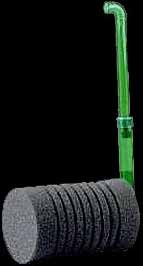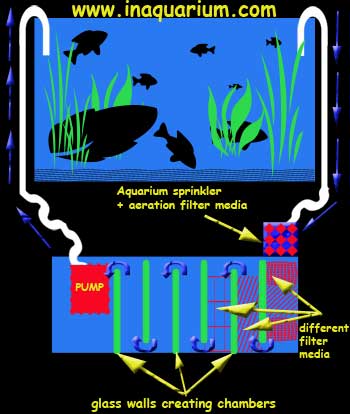In natural environment water is able to regenerate itself. Water in the aquarium do not have that ability almost at all.
This method is effective if is done regularly. It requires water exchange to be done every two weeks by exchanging 25% of the water combined with the desludging substrate.


This filters stop on its surface greater part carried by the water. Filter material can be foam or wool gauze pads . This type of the filter has an additional functionality - it put the water in motion and oxygenates it at the same time.
The main parameter of the mechanical filter is their efficiency which is the amount of filtered water per hour. The table displayed below shows the dependence of the filter efficiency required for the chosen tank size (values are approximate and depend on manufacturer):
| Wielkość akwarium [Litrów] | wydajność filtra [Litrów/h] |
|---|---|
| 40 | 80 - 200 |
| 60 | 100 - 250 |
| 100 | 180 - 380 |
| 125 | 250 - 450 |
| 150 | 300 - 700 |
| 200 | 350 - 850 |
| 250 | 450 - 1000 |
| 500 | 1200 - 1800 |
| 1500 | 2400 - 3000 |
Stops many different (including organic) contamination which is removed by the bacteria spread over the surface of the filter. The amount of oxygen flowing through the filter determines the degree of decomposition of organic compounds. Filter consists of two parts. The first (inlet) part is usually the same material as used for mechanical filters, the second part is fine gravel (bacterial flora develops here). The first layer of the filter should be cleaned frequently, the other layer of the filter (fine gravel) should not be cleaned to often. This second layer should also not be cleaned all at once to protect bacteria. As the bacteria in the filter consume oxygen we need to give the water additional motion. The volume of the filtration material should be at least 1 litre per 100 litres of the aquarium water.

What is a sump? Sump is an external filter which is usually located under the tank. It has several layers and filter compartments. You can have various elements to aerate the water. Usually it is made of smaller aquarium with additional glass partition to create the chambers. Each chamber is filled with different filter media to improve filtration. To increase the water aeration you should raise the pipe (which enters the sump) above the sump's water level.It will create a shower effect which by splashing against filter media aerates the water. Water flows throughout each chamber and than after getting to the last compartment it is pumped back to the main aquarium.You need to remember that water flow should always be continuous. There is a nice diagram displaying water flow in the sump.
Chemocal filter is binding certain chemicals and releasing others. Below I will present most popular types of filters and what they are used for.